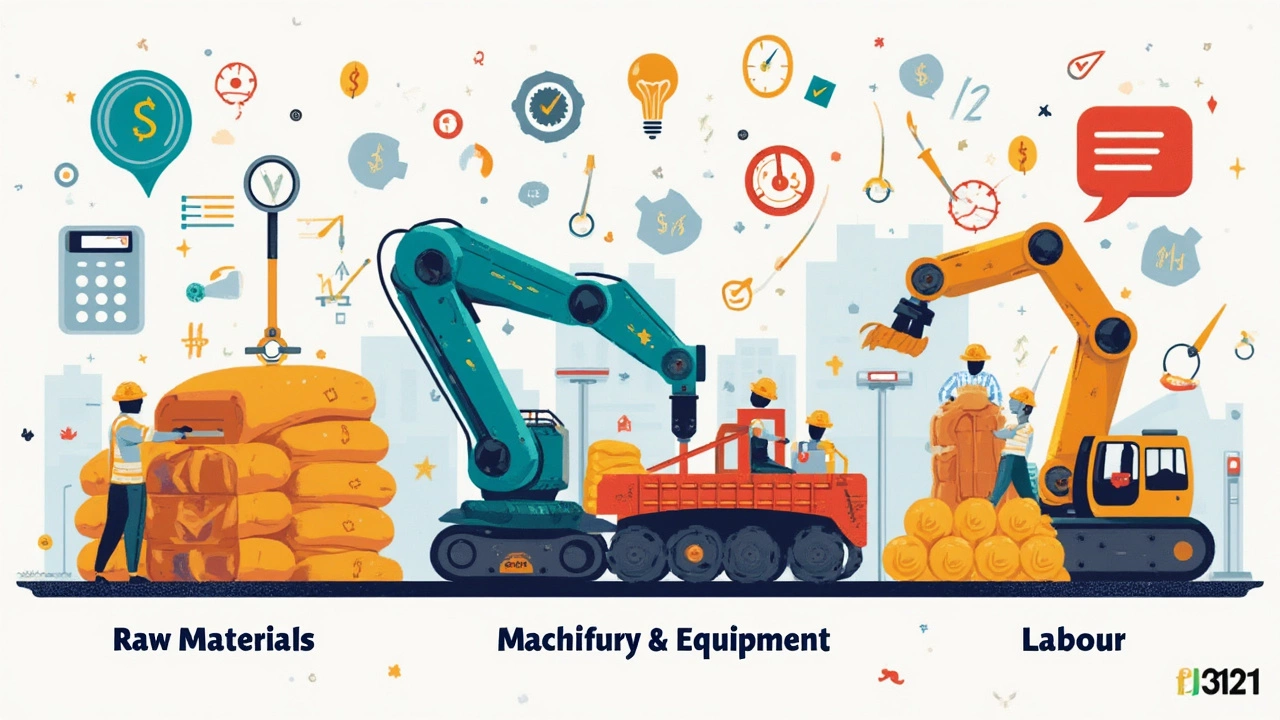If you’re itching to kick off your own manufacturing startup, the bills will hit you before you even switch on the lights. The big shock? Most newbies underestimate just how expensive the first steps are. It’s not just about getting a cool product out the door — it’s also about not going broke before your idea takes off.
Right at the top of your budget, three costs absolutely dominate: the money you shell out for your factory setup or equipment, the paychecks you’ll write for your team, and the piles of cash you’ll throw at raw materials. Missing even one of these in your early planning is a fast track to running out of money. This isn’t theory — a 2023 Small Business Trends report showed that over 60% of failed manufacturing startups admitted they misjudged at least one of these, especially equipment and initial inventory.
The good news? You can dodge rookie mistakes if you know what to expect. Real planning beats guesswork every time. If you’ve got a figure in your head for what you’ll need, bump it up by 20% as a buffer — trust me, unexpected costs pop up like weeds. Let’s break down these epic money pits so you head in with your eyes open.
- Factory or Equipment Costs
- Labor Expenses
- Raw Materials and Inventory
- Hidden Costs to Watch
- Practical Tips to Lower Expenses
Factory or Equipment Costs
If you’re setting up a manufacturing startup, the first gut punch to your wallet is the place and the machines you need. There’s no sugarcoating it — these costs will swallow most of your early budget. For most small manufacturers, getting a space and enough gear to actually make your product eats up anywhere from 30% to 50% of the overall starting budget. In the US, this usually means somewhere between $100,000 for a small leased shop with used machines, up to $1 million if you go bigger or need specialty equipment.
Here’s what you’re usually looking at when it comes to hard costs:
- Leasing or buying your space: Expect deposits, fit-outs, compliance upgrades, and maybe a few headaches with city permits.
- Equipment: Some products, like 3D-printed gadgets or soldered boards, need just a few workstations. But if you’re producing food, machinery or automotive parts, you might shell out for conveyor belts, CNC machines, presses, packaging lines, and more.
- Installation and setup: Machines don’t just show up ready. You’ll have to pay for delivery, installation, calibration, maybe even shipping from overseas.
- Maintenance upfront: Budget for initial servicing and any training your crew needs to run the machines safely.
Check out this quick table of what beginners usually face:
| Item | Low Estimate (USD) | High Estimate (USD) |
|---|---|---|
| Lease Deposit & Buildout | 10,000 | 250,000 |
| Basic Equipment | 40,000 | 500,000 |
| Setup & Installation | 5,000 | 100,000 |
Most startups get sticker shock from little things adding up — electrical work, safety systems, and even just getting heavy machines up a ramp. A trick a buddy used: look for equipment auctions or find closing factories selling machines cheap. There’s risk with buying used, but for stuff like stainless steel tables, it’s a steal. Another tip: If your product line could change, go for flexible production setups. That way you don’t have to buy all new machines if your design tweaks. And don’t forget insurance; lenders and landlords will usually require it before you even unlock the front door.
Labor Expenses
People are your factory’s engine, but they quickly become your biggest recurring expense. When most folks list out costs for a manufacturing startup, they accidentally forget to add up salaries, overtime, training, and taxes. That’s a big mistake. Payroll often eats up more than 30% of a startup’s monthly budget, and it’s not always just paychecks you need to worry about—think health benefits, paid leave, and, in places like California or Europe, strict rules on worker safety and rights.
Don’t forget hiring itself is pricey. A 2023 study by Manufacturing.net found the average cost to hire a skilled worker in manufacturing is roughly $5,000, from ads and screening to onboarding and safety training. Then there’s the learning curve: inexperienced staff can slow down your output or cause expensive mistakes. That’s why investing in people pays off—better workers make mistakes less often, saving you in the long run.
Lucy Tran, CEO of a mid-sized metalwork startup, nailed it when she said,
“If you think new machines are expensive, wait until you see the cost of high employee turnover. Keeping a solid crew is priceless compared to bringing in new bodies all the time.”
If your head’s spinning with all these numbers, try breaking things down like this:
- Wages and salaries (hourly or salaried, depending on your needs)
- Mandatory payroll taxes and insurance (like Social Security, Medicare, and workers’ comp)
- Training and certifications (especially for safety or complex machines)
- Benefits and perks (healthcare, paid time off, bonuses)
- Recruitment and onboarding costs
A smart move is to start lean. Only hire for what you absolutely need at launch. Jumping the gun with a big team can backfire if orders don’t come in right away. Consider contract or temporary staff until demand is steady. If you’re tempted to cut wages to save cash, remember: cheap labor can end up costing more if quality dips or folks walk out.

Raw Materials and Inventory
This part of the budget can be a real gut-punch if you don’t plan carefully. Raw materials and inventory usually eat up a huge chunk of startup costs, often running north of 30% of total expenses for new manufacturing startups. It’s not just about buying the first round either; you’ll need extra supplies to cover mistakes, trial runs, and the lead time before your product actually ships out.
For most manufacturing ideas, there’s no product without raw materials. Whether it’s polymer pellets for injection molding, sheets of steel for custom parts, or even high-grade cardboard for packaging, the prices jump around all the time. One fact that catches people off guard: in 2022, prices for basic industrial metals like aluminum spiked more than 40%. If you got caught flat-footed, your profit margin disappeared overnight.
It’s tempting to buy big to lock in a cheaper price, but that can tie up your cash flow. On the flip side, buying just enough risks missing deadlines if a supplier messes up or you get a bigger order than expected. Here’s what helps:
- Build relationships with more than one supplier, so you have options if prices jump or inventory runs low.
- Start with a small buffer stock—aim for enough raw material to last 1.5x your average turnaround.
- If possible, use software (even a spreadsheet beats nothing) to track what you order, what you use, and what’s sitting around getting dusty. It’s shocking how fast money gets tied up in unused inventory.
- Always ask about minimum order quantities and shipping fees. These small extras pile up.
If you’re selling a physical product, calculate your cost per unit after including shipping, taxes, and even bank fees. Don’t just look at the shelf price. And if you plan on going green with recycled or sustainable materials, be warned: those prices are often higher and don’t always drop with bulk orders like traditional supplies do.
Last tip: talk to others in your industry. Seriously, other founders are often willing to share supplier contacts or warn you if there’s a shortage coming. You might even band together to get a bulk discount neither of you could swing on your own.
Hidden Costs to Watch
No matter how tight you think your budget is, there’s always stuff nobody warns you about. In manufacturing startups, forgetting about these surprise costs can sink you fast. Here’s what trips up founders when they think they’ve covered every angle.
People usually remember machinery and labor, but underestimating the following can break your budget:
- Permits and Environmental Fees: Almost every area requires permits, and these aren’t one-time. Factory zoning, air quality, wastewater—it adds up. In 2024, California’s average manufacturing permitting costs alone hit $13,500, not counting inspection fees.
- Equipment Maintenance and Repairs: Machinery breaks, and repairs never come at a good time. Set aside at least 10% of your annual equipment budget just for fixing stuff you didn’t even realize would break.
- Utilities and Unexpected Rate Hikes: Startup owners often budget for “regular” electric and water bills, but forget that industrial rates are different, and spikes aren’t rare. I know a guy in Ohio whose HVAC bill tripled during last July’s heatwave. He had to dip into line-of-credit just to keep production running.
- Waste Disposal: Mistakes happen and bad batches pile up. Trashing scrap materials can cost thousands. Some places, especially in Europe, charge extra to dispose of industrial waste properly.
- Insurance and Legal Fees: Lawsuits and accidents aren’t fun to think about, but you’ll lose sleep if you aren’t covered. Product liability insurance for small manufacturers averages $12,000 annually in the U.S.
Here’s a tip: build a buffer in your cash flow for these, say 15% above your “main” expenses. Always ask other local founders what costs surprised them. People love sharing these horror stories, and you’ll learn more in one chat than in hours of Googling. Staying sharp on these hidden costs means your manufacturing startup won’t get taken by surprise when reality hits.

Practical Tips to Lower Expenses
Every manufacturing startup wants to save money where it counts. The reality? The difference between staying afloat and going under often comes down to smart decisions in your first year. Let’s dig into proven ways to cut costs without messing up your quality or your sanity.
- Negotiate everything: Don’t accept the first quote for equipment, rent, or raw materials. Suppliers expect you to bargain, so get at least three quotes and play them off each other. A 2023 industry survey found that startups saved an average of 12% just by negotiating — that’s money right back into your business.
- Buy used or lease equipment: Brand-new machines can destroy your starter budget. Check out auctions, certified refurbished gear, and leasing options. You get the same production power for way less upfront cash. Leasing also lets you upgrade as tech improves.
- Keep your first product line simple: It’s tempting to start with a bunch of products, but each new item means more molds, materials, and inventory headaches. Start with your best seller and add new products only once you’re sure you can handle it.
- Automate what you can: Even basic automation — like conveyor belts or robotic arms — cuts labor costs in the long run and keeps output steady. According to the National Association of Manufacturers, early automation pays for itself within 18 months for most small shops.
- Share space and resources: Renting a whole building solo is pricey. A lot of small manufacturers now share industrial spaces, split warehouse costs, or use co-manufacturing hubs. This trend has cut facility expenses by up to 35% for many fresh startups.
If you want to see just how much these choices can matter, check out this data:
| Strategy | Average Savings (Annual) |
|---|---|
| Used Equipment | $36,000 |
| Shared Facility | $18,400 |
| Negotiated Bulk Materials | $21,000 |
| Basic Automation | $27,500 |
Here’s the bottom line: if you focus on one manufacturing startup cost at a time, make smart deals, and start small, you set yourself up to survive long enough to thrive. Don’t try to do it all at once — get the basics running well, and build from there.






Write a comment